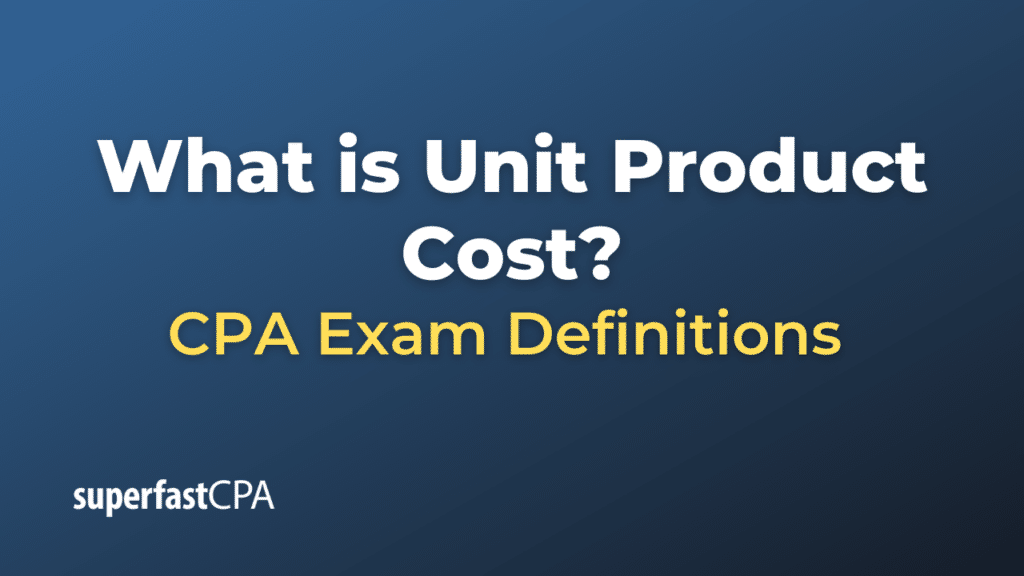Unit Product Cost
Unit product cost refers to the total cost incurred to produce, store, and sell one unit of a particular product. This cost includes not only the direct materials and labor used to manufacture the product but also the overhead costs that are allocated to the product. Knowing the unit product cost is essential for setting selling prices, analyzing profitability, and conducting other kinds of financial analysis and planning.
Formula
The formula to calculate the unit product cost typically is:
Unit Product Cost = Total Production Cost / Number of Units Produced
Where:
- Total Production Cost includes Direct Material Cost, Direct Labor Cost, and Manufacturing Overhead.Total Production Cost=Direct Material Cost+Direct Labor Cost+Manufacturing OverheadTotal Production Cost=Direct Material Cost+Direct Labor Cost+Manufacturing Overhead
- Number of Units Produced is the total quantity of the product that has been manufactured.
Importance:
- Pricing Strategy: Knowing the unit product cost helps companies set appropriate selling prices. Typically, the selling price should be set at a level higher than the unit product cost to achieve a profit margin.
- Cost Control: By understanding the unit product cost, companies can identify areas where costs may be reduced, either through more efficient manufacturing processes or through better sourcing of materials.
- Profitability Analysis : Businesses can evaluate the profitability of different products by comparing their unit product costs with their selling prices.
- Budgeting and Planning: Accurate calculation of the unit product cost is crucial for budgeting and financial planning, as it helps in projecting future costs and revenues.
Understanding the unit product cost is crucial for any business involved in manufacturing or selling products. It’s a key metric for a variety of financial decisions, including pricing, profitability analysis, and strategic planning.
Example of Unit Product Cost
Let’s go through a detailed example of how to calculate the Unit Product Cost.
Scenario
Imagine you own a small bakery, and you want to calculate the Unit Product Cost for a batch of chocolate chip cookies.
Here are your costs for making one batch of 100 cookies:
- Direct Material Cost: Flour, sugar, chocolate chips, etc., amount to $20 for the batch.
- Direct Labor Cost: The baker spends 1 hour making the batch, and you pay the baker $15 per hour.
- Manufacturing Overhead: Utilities, oven depreciation, and other indirect costs come up to $5 for the batch.
Step 1: Calculate Total Production Cost for the batch
First, you need to find the total production cost for making one batch of cookies:
Total Production Cost = Direct Material Cost + Direct Labor Cost + Manufacturing Overhead
Total Production Cost = $20 + $15 + $5 = $40
So, it costs you $40 to make one batch of 100 cookies.
Step 2: Calculate Unit Product Cost
To find the Unit Product Cost, you would divide the total production cost by the number of units (cookies) produced:
Unit Product Cost = Total Production Cost / Number of Units Produced
Unit Product Cost = $40 / 100 = $0.40 per cookie
Interpretation:
You now know that it costs you $0.40 to make one chocolate chip cookie. With this information, you can:
- Set a Selling Price: If you aim for a profit margin of, let’s say, 60%, you would price your cookie at $0.40 + (0.60 x $0.40) = $0.64 at the very least.
- Cost Control: If you think $0.40 is too high, you could look into ways to reduce either your material costs, labor costs, or overhead.
- Profitability Analysis: By knowing your Unit Product Cost, you can more accurately gauge the profitability of your cookies versus other items you might be selling.
- Budgeting and Planning: Knowing your unit cost helps in budget planning and financial forecasting.
Understanding the Unit Product Cost is essential for any business, as it aids in making informed decisions regarding pricing, cost control, and overall financial planning.












